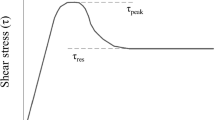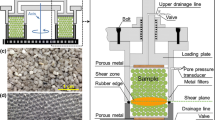Abstract
The shear strength and stiffness of granular materials are crucial parameters for evaluating both stability and sustainability in geoenvironmental engineering. Two types of shear loading, static and cyclic, may directly influence the mechanical properties of granular materials; however, the investigation of stiffness improvement of granular materials has not yet been sufficiently investigated using a loading method. The one-way repeated loading method described in this study may overcome the drawbacks of classical testing approaches. One-way repeated direct shear (DS) and direct simple shear (DSS) tests were conducted on a series of poorly graded bead gradations to investigate the shear strength and stiffness of granular materials under a drained and strain-controlled condition with a shear velocity of 0.1 mm/min. All samples in the two tests were prepared using the same method and initial geometry. Three types of samples referring to different curvature coefficient (Cu) values of 1.8, 3.3, and 5.8 and normal stresses (σn) of 50, 100, and 150 kPa were applied. The test results show that an increase in Cu results in an increase in the shear stress of the granular materials at the peak and ultimate states for both the DS and DSS tests. The peak shear stress ratios between the two tests (τDSS/τDS) ranged from 0.75 to 0.95 when Cu and σn were increased. The angles of shearing resistance from the DS test were in a wide range of 25.7°–33.7° at the peak state and 24.9°–31.3° at the ultimate state, whereas those found in the DSS test were in narrow ranges of 26.0°–28.4° and 23.6°–27.9° at the peak and ultimate states, respectively. It should be noted that an increase in Cu led to the increase in the stiffness ratio in both test methods. The difference in stiffness ratios determined from the DS and DSS tests was approximately 14%. Under one-way repeated shear loading, the DS test is recommended to determine the residual shear strength generated along the shear plane, whereas the DSS test is recommended to determine the maximum shear stress at the weakest shear zone developed horizontally owing to repeated shearing.
Similar content being viewed by others
References
Afzali-Nejad, A., Lashkari, A., and Shourijeh, P.T., 2017, Influence of particle shape on the shear strength and dilation of sand-woven geotextile interfaces, Geotextiles and Geomembranes, 45, 54–66. https://doi.org/10.1016/j.geotexmem.2016.07.005
Al Tarhouni, M.A. and Hawlader, B., 2021, Monotonic and cyclic behaviour of sand in direct simple shear test conditions considering low stresses. Soil Dynamics and Earthquake Engineering, 150, 106931. https://doi.org/10.1016/j.soildyn.2021.106931
Alias, R., Kasa, A., and Taha, M.R., 2014, Particle size effect on shear strength of granular materials in direct shear test. International Journal of Civil, Environmental, Structural, Construction and Architectural Engineering, 8, 1144–1147. https://doi.org/10.5281/zenodo.1096805
Alsaleh, M.I., Alshibli, K.A., and Voyiadjis, G.Z., 2006, Influence of micromaterial heterogeneity on strain localization in granular materials. International Journal of Geomechanics, 6, 248–259. https://doi.org/10.1061/(ASCE)1532-3641(2006)6:4(248)
Alshibli, K.A. and Cil, M.B., 2018, Influence of particle morphology on the friction and dilatancy of sand. Journal of Geotechnical and Geoenvironmental Engineering, 144, 04017118. https://doi.org/10.1061/(ASCE)GT.1943-5606.0001841
Alshibli, K.A. and Roussel, L.E., 2006, Experimental investigation of slip-stick behaviour in granular materials. International Journal for Numerical and Analytical Methods in Geomechanics, 30, 1391–1407. https://doi.org/10.1002/nag.517
Altunbas, A., Soltanbeigi, B., and Cinicioglu, O., 2021, DEM modelling of retained backfill: influence of particle shape for different stress paths and densities. Geomechanics and Engineering, 27, 273–290. https://doi.org/10.12989/gae.2021.273.273
ASTM D3080/D3080M-11, 2014, Standard test method for direct shear test of soils under consolidated drained conditions. Annual Book of ASTM Standards, American Society for Testing and Materials International, West Conshohocken, USA, Vol. 04.08, p. 345–353.
ASTM D422-63, 2014, Standard test method for particle-size analysis of soils. Annual Book of ASTM Standards, American Society for Testing and Materials International, West Conshohocken, USA, Vol. 04.08, p. 4–11.
Bareither, C.A., Benson, C.H., and Edil, T.B., 2008, Reproducibility of direct shear tests conducted on granular backfill materials. Geotechnical Testing Journal, 31, 100878. https://doi.org/10.1520/GTJ100878
Belkhatir, M., Arab, A., Schanz, T., Missoum, H., and Della, N., 2011, Laboratory study on the liquefaction resistance of sand-silt mixtures: effect of grading characteristics. Granular Matter, 13, 599–609. https://doi.org/10.1007/s10035-011-0269-0
Cho, G.-C., Dodds, J., and Santamarina, J.C., 2006, Particle shape effects on packing density, stiffness, and strength: natural and crushed sands. Journal of Geotechnical and Geoenvironmental Engineering, 132, 591–602. https://doi.org/10.1061/(ASCE)1090-0241(2006)132:5(591)
Dai, B.B., Yang, J., and Zhou, C.Y., 2016, Observed effects of interparticle friction and particle size on shear behavior of granular materials. International Journal of Geomechanics, 16, 04015011. https://doi.org/10.1061/(ASCE)GM.1943-5622.0000520
Doygun, O., Brandes, H.G., and Roy, T.T., 2019, Effect of gradation and non-plastic fines on monotonic and cyclic simple shear strength of silica sand. Geotechnical and Geological Engineering, 37, 3221–3240. https://doi.org/10.1007/s10706-019-00838-9
Fannin, R.J., Eliadorani, A., and Wilkinson, J.M.T., 2005, Shear strength of cohesionless soils at low stress. Géotechnique, 55, 467–478. https://doi.org/10.1680/geot.2005.55.6.467
Fei, X. and Zekkos, D., 2017, Comparison of direct shear and simple shear responses of municipal solid waste in USA. Environmental Geotechnics, 5, 158–167. https://doi.org/10.1680/jenge.16.00036
Fukuoka, H., Sassa, K., Wang, G., and Sasaki, R., 2006, Observation of shear zone development in ring-shear apparatus with a transparent shear box. Landslides, 3, 239–251. https://doi.org/10.1007/s10346-006-0043-2
Hamidi, A., Azini, E., and Masoudi, B., 2012, Impact of gradation on the shear strength-dilation behavior of well graded sand-gravel mixtures. Scientia Iranica, 19, 393–402. https://doi.org/10.1016/j.scient.2012.04.002
Hanzawa, H., Nutt, N., Lunne, T., Tang, Y.X., and Long, M., 2007, A comparative study between the NGI direct simple shear apparatus and the Mikasa direct shear apparatus. Soils and Foundations, 47, 47–58. https://doi.org/10.3208/sandf.47.47
Islam, M.N., Siddika, A., Hossain, M.B., Rahman, A., and Asad, M.A., 2011, Effect of particle size on the shear strength behavior of sands. Australian Geomechanics Journal, 46, 75–85. https://doi.org/10.48550/arXiv.1902.09079
Jewell, R.A., 1989, Direct shear tests on sand. Géotechnique, 39, 309–322. https://doi.org/10.1680/geot.1989.39.2.309
JIS A 1224, 2020, Test method for minimum and maximum densities of sands. Japanese Standards Association (JSA), Tokyo, Japan, p. 575–579.
Kouakou, N.M., Cuisinier, O., and Masrouri, F., 2020, Estimation of the shear strength of coarse-grained soils with fine particles. Transportation Geotechnics, 25, 100407. https://doi.org/10.1016/j.tlgeo.2020.100407
Lee, D.-S., Kim, K.-Y., Oh, G.-D., and Jeong, S.-S., 2009, Shear characteristics of coarse aggregates sourced from quarries. International Journal of Rock Mechanics and Mining Sciences, 46, 210–218. https://doi.org/10.1016/j.ijrmms.2008.06.002
Lee, S., Chang, I., Chung, M.-K., Kim, Y., and Kee, J., 2017, Geotechnical shear behavior of Xanthan Gum biopolymer treated sand from direct shear testing. Geomechanics and Engineering, 12, 831–847. https://doi.org/10.12989/gae.2017.12.5.831
Li, L., Yan, H., Xiao, H., Li, W., and Geng, Z., 2021, Sand- and clay-photocured-geomembrane interface shear characteristics using direct shear test. Sustainability, 13, 8201. https://doi.org/10.3390/su13158201
Li, Y.R. and Aydin, A., 2010, Behavior of rounded granular materials in direct shear: mechanisms and quantification of fluctuations. Engineering Geology, 115, 96–104. https://doi.org/10.1016/j.enggeo.2010.06.008
Liu, S., Mao, H., Wang, Y., and Weng, L., 2018, Experimental study on crushable coarse granular materials during monotonic simple shear tests. Geomechancis and Engineering, 15, 687–694. https://doi.org/10.12989/gae.2018.15.1.687
Monkul, M.M., Etminan, E., and Şenol, A., 2016, Influence of coefficient of uniformity and base sand gradation on static liquefaction of loose sands with silt. Soil Dynamics and Earthquake Engineering, 89, 185–197. https://doi.org/10.1016/j.soildyn.2016.08.001
Moon, H.D., Kim, J.S., Woo, S.-W., Tran, D.-K.-L., and Park, S.-S., 2021, Effect of shear rate on strength of non-cemented and cemented sand in laboratory testing. Journal of Korean Geotechnical Society, 37, 23–36. (In Korean) https://doi.org/10.7843/KGS.2021.37.11.23
Moroto, N., 1988, Strength of granular material in simple shear. Soils and Foundations, 28, 85–94. https://doi.org/10.3208/sandf1972.28.2_85
Nong, Z.-Z. and Park, S.-S., 2021, Effect of loading frequency on volumetric strain accumulation and stiffness improvement in sand under drained cyclic direct simple shear tests. Journal of Geotechnical and Geoenvironmental Engineering, 147, 04021159. https://doi.org/10.1061/(ASCE)GT.1943-5606.0002706
Nong, Z.-Z., Park, S.-S., and Lee, D.-E., 2021, Comparison of sand liquefaction in cyclic triaxial and simple shear tests. Soils and Foundations, 61, 1071–1085. https://doi.org/10.1016/j.sandf.2021.05.002
O’Rourke, T.D., Druschel, S.J., and Netravali, A.N., 1990, Shear strength characteristics of sand-polymer interfaces. Journal of Geotechnical Engineering, 116, 451–469. https://doi.org/10.1061/(ASCE)0733-9410(1990)116:3(451)
Ozbay, A. and Cabalar, A.F., 2017, An investigation on stick-slip behaviour of dry spherical glass beads. Proceeding of the Sixth Biot Conference on Poromechanics, Paris, France, Jul. 9–13. https://doi.org/10.1061/9780784480779.222
Park, S.-S. and Jeong, S.W., 2015, Effect of specimen size on undrained and drained shear strength of sand. Marine Georesources & Geotechnology, 33, 361–366. https://doi.org/10.1080/1064119X.2013.879627
Punetha, P., Mohanty, P., and Samanta, M., 2017, Microstructural investigation on mechanical behavior of soil-geosynthetic interface in direct shear test. Geotextiles and Geomembranes, 45, 197–210. https://doi.org/10.1016/j.geotexmem.2017.02.001
Sarkar, D., Goudarzy, M., and König, D., 2019, An interpretation of the influence of particle shape on the mechanical behavior of granular material. Granular Matter, 21, 53. https://doi.org/10.1007/s10035-019-0909-3
Shibuya, S., Mitachi, T., and Tamate, S., 1997, Interpretation of direct shear box testing of sands as quasi-simple shear. Géotechnique, 47, 769–790. https://doi.org/10.1680/geot.1997.47.4.769
Szabó, I., 1994, Up-to-date means of shear strength tests comparison between simple and direct shear. Periodica Polytechnica Civil Engineering, 38, 109–126.
Uesugi, M., Kishida, H., and Tsubakihara, Y., 1989, Friction between sand and steel under repeated loading. Soils and Foundations, 29, 127–137. https://doi.org/10.3208/sandf1972.29.3_127
Uesugi, M., Kishida, H., and Uchikawa, Y., 1990, Friction between dry sand and concrete under monotonic and repeated loading. Soils and Foundations, 30, 115–128. https://doi.org/10.3208/sandf1972.30.115
Wang, X., Cui, J., Zhu, C.Q., Wu, Y., and Wang, X.Z., 2021, Experimental study of the mechanical behavior of calcareous sand under repeated loading-unloading. Bulletin of Engineering Geology and Environment, 80, 3097–3113. https://doi.org/10.1007/s10064-021-02119-3
Wu, P.K., Matsushima, K., and Tatsuoka, F., 2008, Effects of specimen size and some other factors on the strength and deformation of granular soil in direct shear tests. Geotechnical Testing Journal, 31, 100773. https://doi.org/10.1520/GTJ100773
Xu, Y., 2018, Shear strength of granular materials based on fractal fragmentation of particles. Powder Technology, 333, 1–8. https://doi.org/10.1016/j.powtec.2018.03.001
Zhang, J., Andrus, R.D., and Juang, C.H., 2005, Normalized shear modulus and material damping ratio relationships. Journal of Geotechnical and Geoenvironmental Engineering, 131, 453–464. https://doi.org/10.1061/(ASCE)1090-0241(2005)131:4(453)
Acknowledgments
This study was supported by the National Research Foundation of Korea (NRF) grant funded by the Korea Government (MSIT) (No. NRF-2021R1I1A3059731). This work was also supported by the Korea Institute of Geoscience and Mineral Resources (KIGAM) Research Project (No. 22-3412-1).
Author information
Authors and Affiliations
Corresponding author
Additional information
Publisher’s Note Springer Nature remains neutral with regard to jurisdictional claims in published maps and institutional affiliations.
Rights and permissions
About this article
Cite this article
Park, SS., Nguyen, TN., Moon, H.D. et al. Effect of gradation on shear characteristics of granular materials under one-way repeated direct shear and simple shear loadings. Geosci J 27, 613–627 (2023). https://doi.org/10.1007/s12303-023-0018-5
Received:
Accepted:
Published:
Issue Date:
DOI: https://doi.org/10.1007/s12303-023-0018-5




